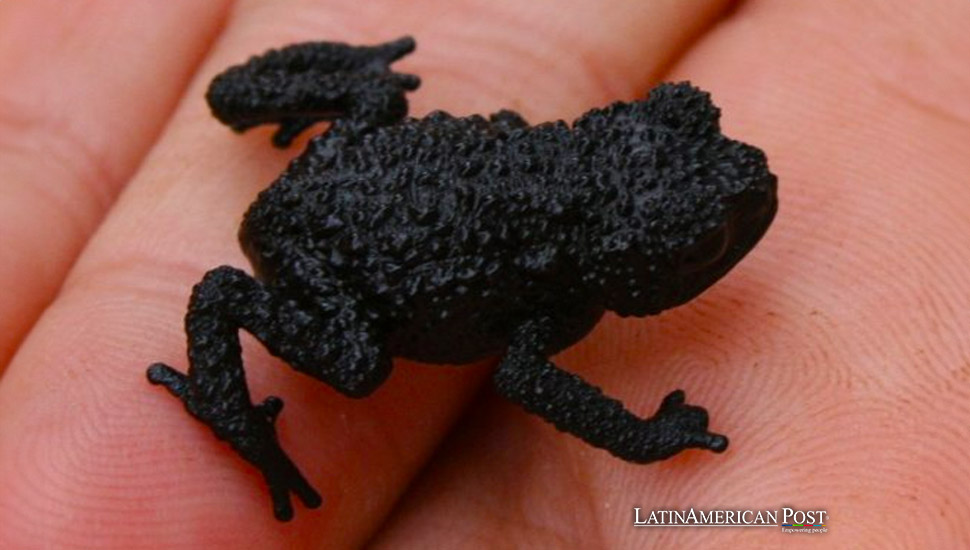Expedition Leads to Discovery of New Frog Species on Venezuela’s Angasima-tepui

An expedition to Venezuela’s remote tepui mountains has led to the discovery of new frog species, now published in Zoological Letters. These findings emphasize the unique biodiversity of these isolated ecosystems and their urgent need for conservation.
In 2011, researcher Philippe Kok embarked on a challenging expedition to Angasima-tepui, one of Venezuela’s remote tabletop mountains, to survey its wildlife. Kok’s goal was to investigate the distribution of the egg-brooding frog Stefania satellites, long thought to inhabit several isolated tepui summits surrounding the Chimantá Massif. However, he suspected that these frogs, separated by vast distances and natural barriers like rivers, might represent multiple species that had been mistakenly grouped.
His suspicions were confirmed during his expedition, as Kok encountered nine tiny brown frogs on the summit of Angasima-tepui. With their brown eyes and translucent bellies, these frogs stood out as potentially new species. After extensive analysis, including multilocus molecular phylogenetic studies, Kok identified the frogs as a new species, Stefania imawari. This discovery and the findings from a nearby mountain were published in the August 2024 issue of Zoological Letters, shedding new light on the rich biodiversity of the tepui ecosystems.
Unveiling Cryptic Species in the Tepuis
The findings published by Kok in Zoological Letters revealed that the species previously identified as Stefania satellites were, in fact, multiple cryptic species. The original distribution of S. satellites was thought to include various tepui summits. However, molecular phylogenetic analyses showed that this species should be restricted to its type locality on the summit of Aprada-tepui in Bolívar State. The populations of frogs previously grouped under the name S. satellites on other tepuis were distinct species that had yet to be described.
Kok’s research identified two new species, Stefania imawari from Angasima-tepui and Stefania’s uptime from Upuigma-tepui. These species were previously referred to in the literature as Stefania sp. three and S. sp. 5, respectively. Both species are part of the Stefania ginesi clade, a group of frogs that exclusively inhabit the summits of Tepuis. The discovery of these new species highlights life’s complex and often hidden diversity in these isolated environments, where distinct species can evolve in close proximity but remain separate due to geographic isolation.
The Unique Traits of Stefania Imawari
Stefania imari is a small frog measuring just over 2 inches in length. Its distinctive physical features differentiate it from other species. It has a rounded snout, large tongue, flared lips, and dark brown eyes that sometimes exhibit a faint blueish-grey tint. The frogs’ skin coloration varies widely, from golden brown to dark greenish brown, and they possess slightly translucent bellies that allow some internal organs to be visible.
One of the most remarkable aspects of Stefania Imawari is its reproductive behavior. Like other Stefania species, the females carry their eggs on their backs. During mating, the eggs are attached to the female’s dorsum by secretions, and the developing embryos remain there until they hatch into froglets. Although Kok did not observe Stefania imawari females carrying eggs during his expedition, he found evidence of this behavior, such as a glutinous patch on one female’s back. This unique reproductive strategy and the frog’s cryptic coloration and habitat preferences underscore its specialized adaptation to the tepui environment.
Conservation Challenges for Tepui Species
The discovery of Stefania Imawari and Stefania Upuigmae raises significant conservation concerns. Both species have highly restricted geographic ranges, with habitats limited to areas smaller than 3 square kilometers on their respective tepui summits. Due to their limited distribution and the specific environmental conditions required for their survival, these species are at high risk of extinction. Kok’s research, published in Zoological Letters, suggests that both species should be listed as Critically Endangered according to IUCN criteria.
While rich in biodiversity, the tepui ecosystems are also incredibly fragile. Their isolated nature means that species like Stefania imawari have evolved in complete isolation, making them highly vulnerable to changes in their habitat. Climate change, habitat destruction, and other anthropogenic factors threaten these ecosystems significantly. Protecting these species requires immediate conservation efforts to preserve their unique habitats and prevent further biodiversity loss.
Also read: Venezuela launches game development course to boost tech education
The findings from Kok’s expedition emphasize the importance of continued exploration and study of the world’s least accessible regions. The discovery of new species in these remote areas adds to our understanding of global biodiversity. It highlights the urgent need for conservation initiatives to protect these ecosystems from the growing threats they face. The remote tepuis of Venezuela, with their hidden and fragile ecosystems, represent one of the last frontiers of biodiversity on our planet—frontiers that we must strive to protect for future generations.





